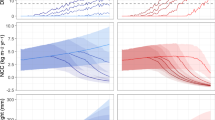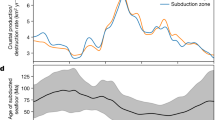Abstract
POLARITY coincidence correlation was recently applied to a lower Carboniferous sequence from the south of Scotland1 in an attempt to establish the existence of “a fundamental cycle of about 145 ft. in the vertical change in sea level during the lower Carboniferous period in Great Britain”. Some of the geological assumptions made in order to carry out the mathematical analysis are of arguable validity, but of more immediate interest are the conclusions. The authors decided (page 137) that “isostatic readjustments … drive the cyclicity”. Many other writers2–6 have appealed to “external” factors to account for cyclicity in Carboniferous sequences. On the other hand, “internal” mechanisms, such as normal sedimentary processes in a deltaic regime, have been invoked7,8 to produce Yoredale-type cycles. It has also been shown quantitatively9 that the changes of environment evidenced in Coal Measures cyclic deposits are not regular, either vertically or laterally; and again a sedimentary control has been suggested.
Similar content being viewed by others
Article PDF
References
Carss, B. W., and Neidell, N. S., Nature, 212, 136 (1966).
Westoll, T. S., C.R. IV Cong. Strat. Geol. Carbon. Heerlen, 1958, 3, 767 (1962).
Weller, J. M., Bull. Amer. Assoc. Petrol. Geol., 40, 17 (1956).
Wanless, H. R., and Shepard, F. P., Bull. Geol. Soc. Amer., 47, 1177 (1936).
Wells, A. J., Geol. Mag., 97, 389 (1960).
Bott, M. H. P., Nature, 201, 1082 (1964).
Moore, D., Proc. Yorks. Geol. Soc., 31, 91 (1958).
Goodlet, G. A., Trans. Edin. Geol. Soc., 17, 217 (1959).
Duff, P. McL. D., and Walton, E. K., Sedimentology, 1, 235 (1962).
Anderson, J. A. R., The Garden's Bull. Singapore, 20, 131 (1963).
Smith, A. H. V., Proc. Yorks. Geol. Soc., 33, 423 (1962).
Author information
Authors and Affiliations
Rights and permissions
About this article
Cite this article
DUFF, P. Sedimentary-edaphic Control Theory of Cyclic Sedimentation. Nature 214, 159 (1967). https://doi.org/10.1038/214159a0
Received:
Revised:
Issue date:
DOI: https://doi.org/10.1038/214159a0



